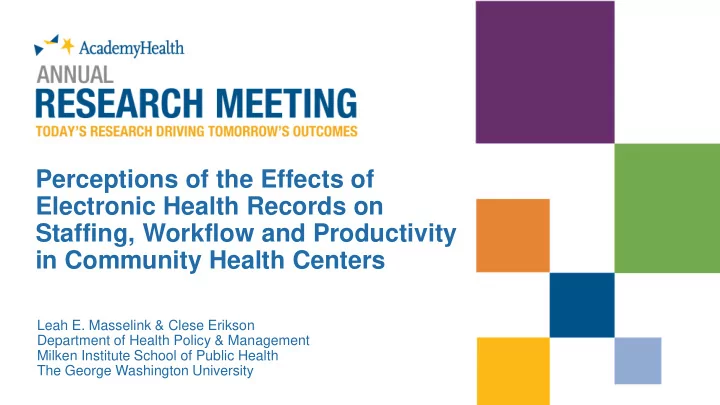

1 Perceptions of the Effects of Electronic Health Records on Staffing, Workflow and Productivity in Community Health Centers Leah E. Masselink & Clese Erikson Department of Health Policy & Management Milken Institute School of Public Health The George Washington University
Background 2 • Many community health centers (CHCs) have implemented electronic health records (EHRs) in recent years • Number of CHCs using EHRs has more than doubled since 2009 • Supported by federal investments under Health Information Technology for Economic and Clinical Health Act & Affordable Care Act • EHR implementation has been linked to new and changing staff roles in primary care settings • New roles: scribes, IT staff, quality improvement staff • Changing roles: medical assistants, nurses
Background 3 • EHR implementation is known to cause significant changes to clinicians’ use of time and productivity • Clinicians spend more time on charting & disease prevention tasks, less time on prescribing & within-office communication (Howard et al. 2013) • Increase productivity for new problems & procedure-related visits, reduce productivity for preventive visits (Furukawa et al. 2011) • EHR implementation by CHCs enables study of how new technology intersects with staffing changes to influence care delivery • CHCs use flexible and innovative staffing models (Ku et al. 2014) • CHCs are subject to data reporting requirements & incentives (Uniform Data System, Meaningful Use) that may influence staffing decisions, workflows and productivity
Study Objectives 4 • To understand how community health centers ’ implementation of electronic health records has changed staffing models, staff roles and workflows • To understand the mechanisms by which using electronic health records influences staff productivity, coordination between providers and quality of care in community health centers
Methods 5 • Qualitative exploratory study of 6 CHCs with a variety of staffing configurations and EHR experience levels • Research questions: • How do clinicians, support staff, and administrators believe that EHR implementation changed staff roles and staffing models in CHCs? • How do clinicians, support staff, and administrators believe that EHR implementation changed workflow and productivity in CHCs? • How do clinicians, support staff, and administrators believe that have these changes influenced coordination between providers and quality of care in CHCs?
Methods 6 • Identified potential sites using 2014 Uniform Data System data • Aimed for variety of CHC size, state policy context, EHR experience level, EHR system • Invited potential participants via email and telephone • Conducted telephone interviews with 17 CHC administrators, support staff & clinicians • Questions: history of EHR implementation; perceptions of how EHRs influence staff roles and workflow; productivity; and coordination and quality of care • Audio recorded & transcribed interviews • Conducted thematic analysis of interview transcripts in ATLAS.ti
Findings 7 • CHCs add and expand staff roles after EHR implementation • Most new staff are in support roles — licensed practical nurses (LPNs), medical assistants (MAs), or quality improvement (QI) staff • Some CHCs hire information technology (IT) staff, while others outsource IT support tasks to external networks or EHR vendors • “Every person [can] work at the top of their license”— CHCs can upgrade involvement of support staff in workflows using EHR tools like standing orders and medication lists • EHRs improve coordination within CHCs • Facilitate sharing of information, medication lists, and behavioral and dental health records within CHCs
Findings 8 • EHRs have limited impact on coordination between CHC providers and outside providers • CHC staff use manual entry and add-on products to facilitate communication • EHRs help to enhance quality of care and population health in CHCs • EHRs enable identification of patients who need preventive care and motivate workflow or staffing changes to improve quality of care • EHRs contribute to reduced productivity in CHCs • Frequent EHR software updates, extra clicking and navigation required to input information into the EHR, and extensive quality reporting requirements slow down visits and workflows
Conclusions 9 • CHCs are finding creative ways to adapt staff roles and models to use EHRs to improve coordination and quality of care • Many new staff roles are designed to take advantage of EHR functions to reduce provider burden (e.g. upgraded MA or LPN roles) or improve population health and quality tracking (e.g. new QI staff) • Other roles are designed to manage new challenges introduced by the EHR (e.g. new IT staff) • Influence of EHRs on hiring enabling staff (e.g. case managers) is less direct because their work is less “documentable” in EHRs
Conclusions 10 • EHRs can be useful in fostering team-based approaches to care by making providers more willing to delegate tasks to other providers or staff members • As EHRs become more embedded in practice over time, they could become a valuable new tool for CHC leaders to analyze the contributions of different staff members and optimize their staff configurations • Given ongoing reported challenges with productivity after EHR implementation, it will also be important to continue to monitor productivity trends at CHCs as they adopt new technologies and care models
Limitations 11 • Used 2014 UDS data to identify potential sites • Does not include information on recent adopters (CHCs that implemented EHRs in 2014 or later) • Most participating CHCs were large (vs. all CHCs) • Experiences of using EHRs may be distinct from those of smaller CHCs • Some informants started working at CHCs after EHR implementation was complete • Could not speak directly about pre-implementation experiences and implementation processes
Funding Source 12 • Health Resources & Services Administration • Health Workforce Research Center Cooperative Agreement: Flexible & Novel Use of Health Workers
13 Thank you! Leah Masselink lmasselink@gwu.edu Report available at http://gwhwi.org (GW Health Workforce Institute)
Recommend
More recommend